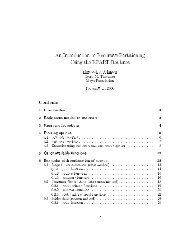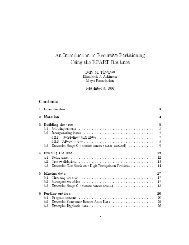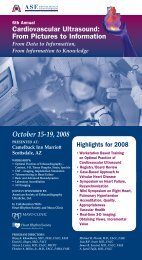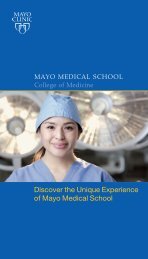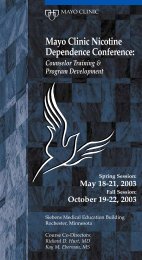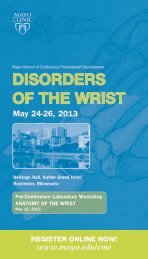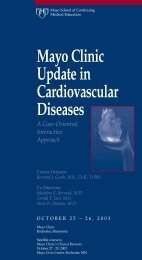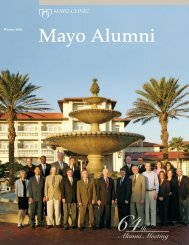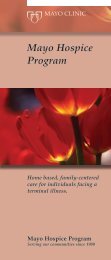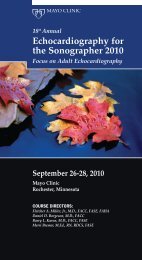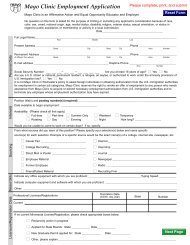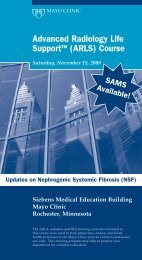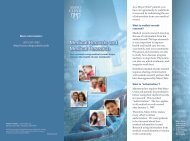Mayo Alumni Magazine 2002 Spring - MC4409-0402 - Mayo Clinic
Mayo Alumni Magazine 2002 Spring - MC4409-0402 - Mayo Clinic
Mayo Alumni Magazine 2002 Spring - MC4409-0402 - Mayo Clinic
Create successful ePaper yourself
Turn your PDF publications into a flip-book with our unique Google optimized e-Paper software.
Invisible to the eye, anthrax grows to<br />
visible dimension when cultured.<br />
Tom Smith, Ph.D., is <strong>Mayo</strong>’s director<br />
of Virology. Jim Uhl, M.Sc., is an<br />
associate member of the Division of<br />
Microbiology. Other clinical<br />
microbiologists who are members of<br />
the team include: Jon Rosenblatt, M.D.;<br />
Mark Espy and Lynne Sloan; and<br />
Maj. Constance Bell, Ph.D., a United<br />
States Army officer who completed a<br />
clinical microbiology fellowship at<br />
<strong>Mayo</strong> <strong>Clinic</strong> in June 2001.<br />
Maj. Bell laid the groundwork for<br />
the anthrax test by developing reagents<br />
for it but finalized her fellowship and<br />
returned to active duty in the armed<br />
forces before the development of the<br />
test could be completed. Ironically, four<br />
days before the terrorist attacks, she<br />
requested additional time to complete<br />
the paperwork on the anthrax test.<br />
Presenting the project would be<br />
difficult, she thought, without an<br />
apparent, immediate need.<br />
In a case of famous last words, Uhl<br />
replied, “Don’t worry. There’s no<br />
urgency on that one.”<br />
After September 11, the team put<br />
other projects aside and worked<br />
around the clock to complete the test.<br />
“We had already worked with <strong>Mayo</strong><br />
Medical Ventures to establish a<br />
successful collaboration with Roche<br />
Applied Science,” says Dr. Cockerill.<br />
“When the first anthrax case appeared<br />
in October, we stepped up our<br />
collaboration to produce laboratory test<br />
kits for the rapid anthrax test. In a<br />
matter of days, we were able to send<br />
the formula for the reagents to the<br />
Roche Applied Science plant in<br />
Penzsberg, Germany. With air travel<br />
being limited, we were concerned<br />
about the logistics of transporting<br />
shipments, but we had tremendous<br />
cooperation from the federal<br />
government.”<br />
To speed the preliminary<br />
diagnosis, the test kits needed to be<br />
available in other LightCyclerequipped<br />
laboratories around the<br />
country.<br />
“Making this test available in a<br />
very short time frame is our<br />
contribution to the fight against<br />
bioterrorism. The work is a direct<br />
outcome of the excellent cooperation<br />
between Roche Applied Science and<br />
<strong>Mayo</strong> <strong>Clinic</strong>,” says Martin Madaus,<br />
president and chief executive officer<br />
of Roche Diagnostics Corporation.<br />
“<strong>Mayo</strong> researchers have several years<br />
of experience in developing these<br />
types of assays. By combining our<br />
efforts, we were able to make this test<br />
available to qualified laboratories<br />
only a few weeks after beginning this<br />
initiative.”<br />
Since Nov. 9, Roche Applied<br />
Science made the test widely<br />
available to public health agencies,<br />
hospital laboratories and reference<br />
laboratories in the United States and<br />
other countries.<br />
6 <strong>Mayo</strong> <strong>Alumni</strong> <strong>Spring</strong> <strong>2002</strong>



